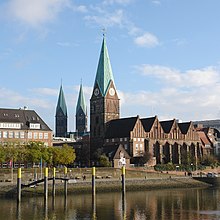
The St. Martin's Church (German: St. Martini) is a Protestant Lutheran and Reformed church in the old town of Bremen. It is located near the Weser river and is one of the oldest churches in the city.

The St. Martin's Church (German: St. Martini) is a Protestant Lutheran and Reformed church in the old town of Bremen. It is located near the Weser river and is one of the oldest churches in the city.
The church was founded in 1229. [1] The late-Gothic brick building suffered severe damage in 1944 and was rebuilt after the war. In 1973, the church was listed under the monument protection act.
Hallmark is a small, primarily residential neighborhood in western Louisville, Kentucky, United States founded in 1965. Its boundaries are Cane Run Road to the west, Algonquin Parkway to the north, and Cypress street to the east. The origins of its name are not known. The area sits along Algonquin Park east to west near the border of Louisville and Shively. There are few distinctions that separate Hallmark from the surrounding areas of Park Duvalle or Shively.
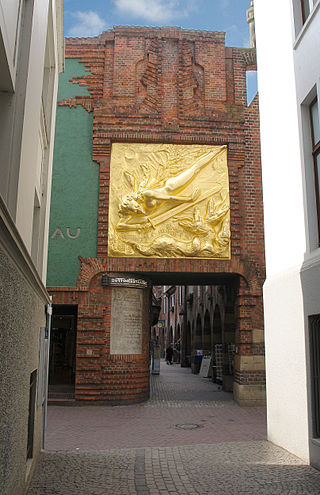
Böttcherstraße is a street in the historic centre of Bremen, Germany. Only about 100 m (330 ft) long, it is famous for its unusual architecture and ranks among the city's main cultural landmarks and visitor attractions. Most of its buildings were erected between 1922 and 1931, primarily as a result of the initiative of Ludwig Roselius, a Bremen-based coffee-trader, who charged Bernhard Hoetger with the artistic supervision over the project. The street and its buildings are a rare example of an architectural ensemble belonging to a variant of the expressionist style. Several of the houses can be classed as Brick Expressionism. Since 1973, the ensemble has been protected by the Monument Protection Act.
Mierzynek is a village in the administrative district of Gmina Lubicz, within Toruń County, Kuyavian-Pomeranian Voivodeship, in north-central Poland. It lies approximately 3 kilometres (2 mi) east of Lubicz and 13 km (8 mi) east of Toruń.

Porosły-Kolonia is a village in the administrative district of Gmina Choroszcz, within Białystok County, Podlaskie Voivodeship, in north-eastern Poland.
Kozowszczyzna is a settlement in the administrative district of Gmina Juchnowiec Kościelny, within Białystok County, Podlaskie Voivodeship, in north-eastern Poland.

Schnoor is a neighbourhood in the medieval centre of the German city of Bremen, and the only part of it that has preserved a medieval character. The neighbourhood owes its name to old handicrafts associated with shipping. The alleys between the houses were often associated with occupations or objects: There was an area in which ropes and cables were produced and a neighboring area, where wire cables and anchor chains were manufactured.
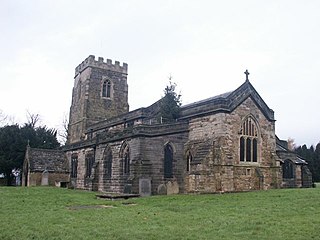
St. Helen's Church, Selston is a parish church in the Church of England in Selston, Nottinghamshire.
Będźmierowice is a village in the administrative district of Gmina Czersk, within Chojnice County, Pomeranian Voivodeship, in northern Poland. It lies approximately 5 kilometres (3 mi) east of Czersk, 35 km (22 mi) east of Chojnice, and 74 km (46 mi) south-west of the regional capital Gdańsk.
Bukowa Góra is a settlement in the administrative district of Gmina Czersk, within Chojnice County, Pomeranian Voivodeship, in northern Poland.
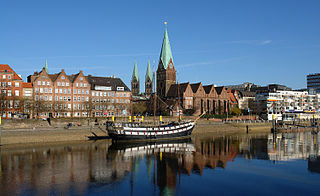
The Schlachte is a promenade along the east bank of the River Weser in the old town of Bremen in the north of Germany. Once one of the city's harbours, it is now popular for its restaurants, beer gardens and river boats.

Domsheide is a major square in the city of Bremen, Germany. It is located east of the Marktplatz and south of Bremen Cathedral. Streets leading to it include Ostertorstraße, Dechanatstraße, Balgebrückstraße and Violenstraße. It contains a number of important buildings, including the main post office, the courthouse, the cathedral precinct with the bell, and the annex to the stock market building. It is one of three main hubs of the public transport network, with most tram routes and two important bus lines crossing the square. The design of the Domsheide is relatively uneven, characterized by materials such as sandstone, dark red brick, red and yellow clinkers, render, concrete and marble.
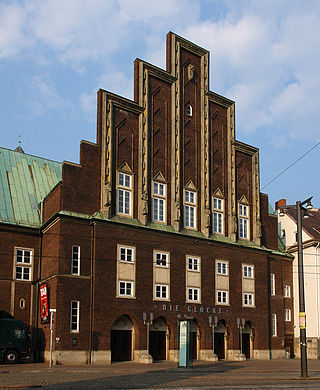
Die Glocke is a concert hall in the centre of Bremen, Germany. Standing on the site of a building from the Middle Ages, it was designed by Walter Görig (1885–1974) and completed in 1928. Its elegant Art Deco design and excellent acoustics have been praised by a number of artists including Herbert von Karajan.
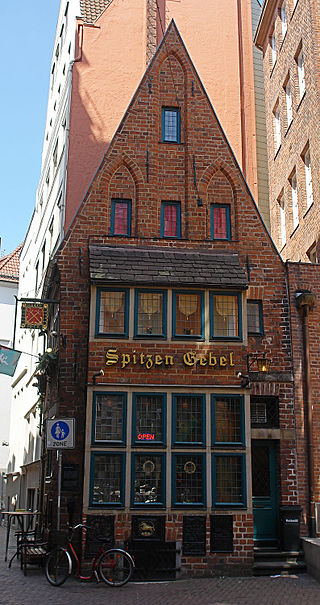
Spitzen Gebel is a historic building in the centre of Bremen, Germany, located at No. 1, Hinter dem Schütting. Its origins date to the year 1400, but it was rebuilt in the Gothic style in 1590 with additions in 1610. Since 1973, it has been a listed building.

The Landherrnamt is a building in the Schnoor district of Bremen, Germany, which was designed by Alexander Schröder in the Neo-Romanesque style and completed in 1856.

The Glockenspiel House is a building in Bremen in the north of Germany. With its 30 bells of Meissen porcelain, the carillon (Glockenspiel) chimes three times a day while wooden panels depicting pioneering seafarers and aviators appear on a rotating mechanism inside the tower.

The Ludwig Roselius Museum on Böttcherstraße in the old town of Bremen, Germany, houses the private collection of the successful coffee merchant Ludwig Roselius (1874–1943). Artefacts from the Middle Ages to the Baroque period are on display. The house itself which was completed in 1588 has a history going back to the 14th century.

St Catherine's Monastery in Bremen, Germany, was founded in 1253 by the Dominicans. Today traces of its existence remain in the area of the Katharinenstraße and Katharinenklosterhof in the old town.
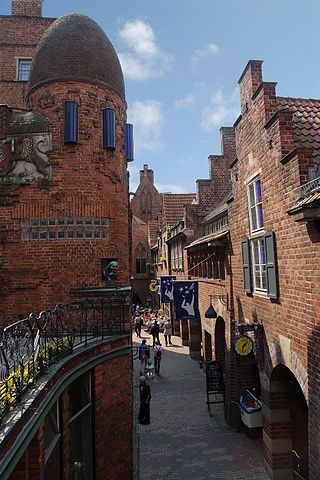
St Petrus House is a historic building in Bremen, Germany. With features of North-German Gothic architecture including an arcade, it was built in 1927 by the prosperous coffee merchant Ludwig Roselius as part of his development of Böttcherstraße. Today its newly refurbished dining rooms are part of the Atlantic Grand Hotel. Since 1973, St Petrus House has been a listed building.
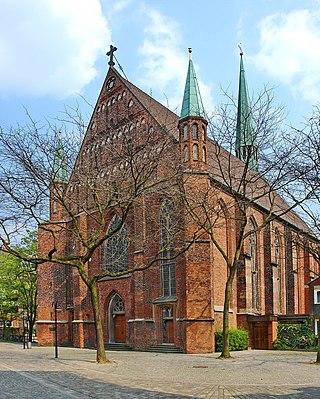
St. John's Church is a Roman Catholic provost church in Bremen. It was built in the fourteenth century as a Franciscan abbey church and has been a listed monument since 1973.
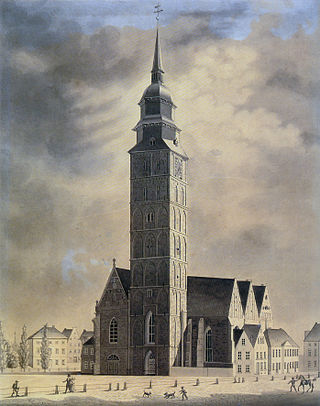
St. Ansgarii Church was a medieval Brick Gothic church in Bremen. The 97-meter-high tower was the tallest landmark of the city for centuries. The church was the starting point of the Reformation in Bremen. The building was severely damaged during World War II and the ruin was demolished in the 1950s. A new church building under the same name was constructed outside of the old city.